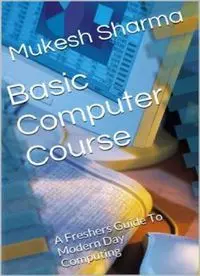Table Of Content— Based on Latest Pattern As Per D.G.E.T. Guidelines
— Basic Computer Course
Mukesh Sharma
Abhishek Publications, Chandigarh/New Delhi
All rights reserved. No part of this book may be reproduced or transmitted in any
form or by any means, electronic or mechanical, including photocopying,
recording or by any information storage and retrieval system, without permission
in writing from the publishers/copyright owner.
ISBN : 978-81-8247-480-2
Copyright : Author First Edition : 2013
Price :
Published by :
Abhishek Publications
Chandigarh Office : SCO 57-59, Sector 17-C, Chandigarh-17
Phone : 0172-5003768 Telefax : 0172-2707562
Branch Office : 7/10, Ansari Road, Darya Ganj, New Delhi-2
Phone : 011-30130936
e-mail :
OUTLINE SYLLABUS
Theory Tutorials Practical
01. Knowing Computer
02. Operating Computer using GUI based Operating System 03.
Understanding Word Processing
04. Using Spreadsheet
05. Communicating using the Internet
06. WWW and Web Browsers
07. Communications and Collaboration
08. Making Small Presentation
DETAILED SYLLABUS
Knowing Computer
1.0 Introduction
1.1 Objectives
1.2 What is Computer?
1.2.1 Basic Applications of Computer 1.3 Components
of Computer System
1.3.1 Central Processing Unit 1.3.2 Keyboard, Mouse
and VDU
1.3.3 Other Input Devices 1.3.4 Other Output Devices
1.3.5 Computer Memory
1.4 Concept of Hardware and Software
1.4.1 Hardware
1.4.2 Software
1.4.2.1 Application Software
1.4.2.2 Systems Software
1.5 Concept of Computing, Data and Information 1.6
Applications of IECT
1.6.1 e-Governance
1.6.2 Entertainment
1.7 Bringing Computer to life
1.7.1 Connecting Keyboard, Mouse, Monitor and Printer to
CPU
1.7.2 Checking Power Supply 1.8 Summary
1.9 Model Answers
OPERATING COMPUTER USING GUI BASED OPERATING SYSTEM
2.0 Introduction
2.1 Objectives
2.2 Basics of Operating System
2.2.1 Operating System
2.2.2 Basics of Popular Operating System (LINUX,
WINDOWS) 2.3 The User Interface
2.3.1 Task bar
2.3.2 Icons
2.3.3 Menu
2.3.4 Running an application 2.4 Operating System
2.4.1 Changing System Date and Time 2.4.2 Changing
Display Properties 2.4.3 To Add or Remove A Windows Component
2.4.4 Changing Mouse Properties 2.4.5 Adding and Removing
Printers 2.5 File and Directory Management
2.5.1 Creating and Renaming of Files and Directories 2.6
Common Utilities
2.7 Summary
2.8 Model Answers
UNDERSTANDING WORD PROCESSING
3.0 Introduction
3.1 Objectives
3.2 Word Processing Basics
3.2.1 Opening Word Processing Package 3.2.2 Menu
Bar
3.2.3 Using the Help
3.2.4 Using the Icons below Menu Bar 3.3 Opening
and Closing Documents
3.3.1 Opening Documents 3.3.2 Save and Save as
3.3.3 Page Setup
3.3.4 Print Preview
3.3.5 Printing of Documents 3.4 Text Creation and
Manipulation
3.4.1 Document Creation 3.4.2 Editing Text
3.4.3 Text Selection
3.4.4 Cut, Copy and Paste 3.4.5 Spell Check
3.4.6 Thesaurus
3.5 Formatting of Text
3.5.1 Font and Size Selection 3.5.2 Alignment of Text
3.5.3 Paragraph Indenting 3.5.4 Bullets and Numbering 3.5.5
Changing Case
3.6 Table Manipulation
3.6.1 Draw Table
3.6.2 Changing Cell width and Height 3.6.3
Alignment of Text in Cell 3.6.4 Delete / Insertion of row and column
3.6.5 Border and Shading 3.7 Summary
3.8 Model Question & Answers
USING SPREADSHEET
4.0 Introduction
4.1 Objectives
4.2 Elements of Electronic Spreadsheet 4.2.1 Opening of
Spreadsheet 4.2.2 Addressing of Cells 4.2.3 Printing of
Spreadsheet 4.2.4 Saving Workbooks
4.3 Manipulation of Cells
4.3.1 Entering Text, Numbers and Dates 4.3.2
Creating Text, Number and Date Series 4.3.3 Editing Worksheet Data
4.3.4 Inserting and Deleting Rows, Columns 4.3.5 Changing
Cell Height and Width 4.4 Formulas and Function
4.4.1 Using Formulas
4.4.2 Function
4.5 Summary
4.6 Model Answers
COMMUNICATION USING THE INTERNET
5.0 Introduction
5.1 Objectives
5.2 Basic of Computer Networks
5.2.1 Local Area Network (LAN) 5.2.2 Wide Area
Network (WAN) 5.3 Internet
5.3.1 Concept of Internet 5.3.2 Applications of
Internet 5.3.3 Connecting to the Internet 5.3.4 Troubleshooting
5.4 Summary
5.5 Model Answers
WWW AND WEB BROWSER
6.0 Introduction
6.1 Objectives
6.2 World Wide Web (WWW)
6.3 Web Browsing Softwares
6.3.1 Popular Web Browsing Softwares 6.4 Search
Engines
6.4.1 Popular Search Engines / Search for content 6.4.2
Accessing Web Browser 6.4.3 Using Favorites Folder 6.4.4
Downloading Web Pages 6.4.5 Printing Web Pages 6.5
Understanding URL
6.6 Surfing the Web
6.6.1 Using e-Governance Website 6.7 Summary
6.8 Model Answers
COMMUNICATIONS AND COLLABORATION
7.0 Introduction
7.1 Objectives
7.2 Basics of E-mail
7.2.1 What is an Electronic Mail 7.2.2 E-mail
Addressing 7.3 Using E-mails
7.3.1 Opening E-mail Account 7.3.2 Mailbox: Inbox
and Outbox 7.3.3 Creating and Sending a new E-mail 7.3.4
Replying to an E-mail message 7.3.5 Forwarding and E-mail message
7.3.6 Sorting and Searching E-mails 7.4 Document
Collaboration
7.5 Instant Messaging and Collaboration 7.5.1 Using instant
messaging 7.5.2 Instant messaging providers 7.5.3 Netiquettes
7.6 Summary
7.7 Model Answers
MAKING SMALL PRESENTATIONS
8.0 Introduction
8.1 Objectives
8.2 Basics
8.2.1 Using PowerPoint
8.2.2 Opening a PowerPoint Presentation 8.2.3 Saving
a Presentation 8.3 Creating a Presentation
8.3.1 Creating a Presentation using a Template 8.3.2
Creating a Blank Presentation 8.3.3 Entering and Editing Text 8.3.4
Inserting and Deleting Slides in a Presentation 8.4 Preparation
of Slides
8.4.1 Inserting Word Table or an Excel Worksheet 8.4.2
Adding Clip Art Pictures 8.4.3 Inserting Other Objects 8.4.4
Resizing Other Objects 8.5 Presentation of Slides
8.5.1 Viewing a Presentation 8.5.2 Choosing a Set up
for Presentation 8.5.3 Printing Slides and Handouts 8.6 Slide
Show
8.6.1 Running a Slide Show 8.6.2 Transition and Slide
Timings 8.6.3 Automating a Slide Show 8.7 Summary
8.8 Model Answers

